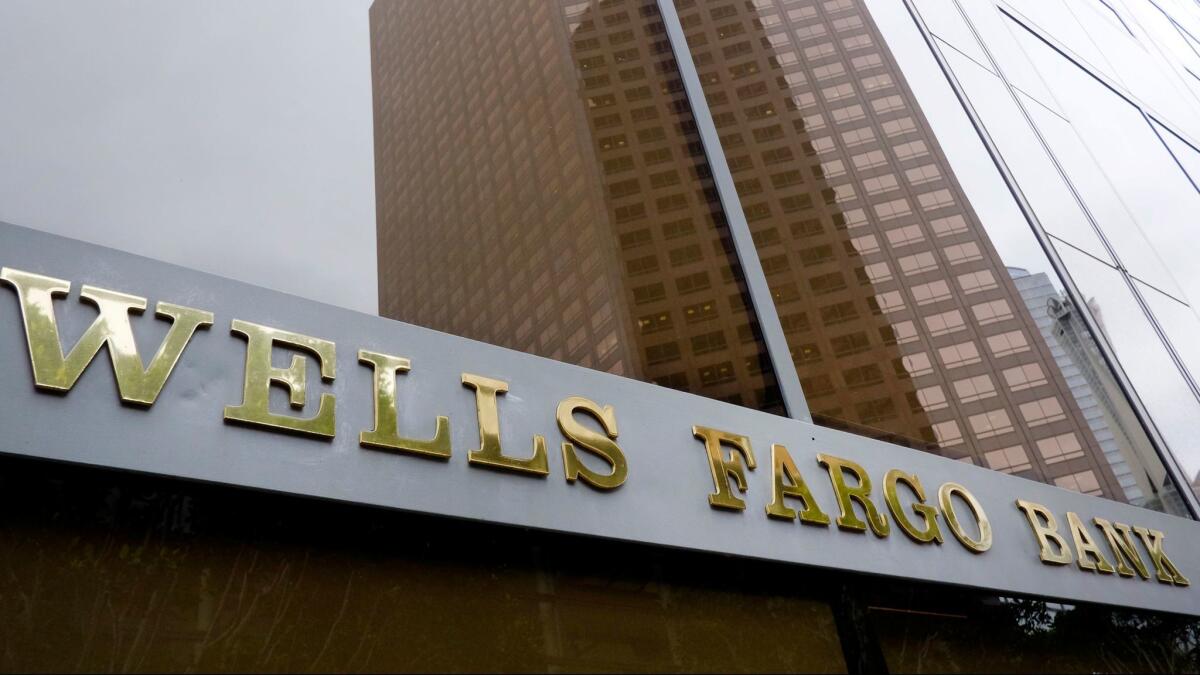Column: Borrowers say ‘stealth’ mortgage modifications by Wells Fargo could cost them their homes

Wells Fargo is facing allegations of a new scandal, this time involving its treatment of mortgage borrowers in bankruptcy.
Some of the borrowers allege that the bank attempted to quietly modify their mortgages so that their monthly payments would be lower — but the length of the loans would be longer, sometimes by decades.
The changes were made, the borrowers’ lawyers say, in a way that might expose them to default judgments or even foreclosures. The lawyers also say the bank tried to make the changes behind the backs of bankruptcy judges, who normally would have to approve any loan modifications in advance.
“They’re manufacturing defaults,” says Theodore O. Bartholow III, a Dallas attorney who filed a class-action legal complaint earlier this month in federal bankruptcy court in Charlotte, N.C. Bartholow alleges that Wells Fargo is trying to “force stealth modifications upon its unsuspecting Chapter 13 debtor customers.” The result is a “virtual hijacking” of the debtors’ bankruptcy cases.
Wells “strongly denies the claims,” a bank spokesman, Tom Goyda, said in an email. He said the bank makes no changes to mortgages “without receiving signed documents from the customer and, where required, approval from the bankruptcy court.”
The loans in Bartholow’s lawsuit and other legal complaints making similar allegations were in fact “not modified,” Goyda said, but were the subjects of modification offers sent by letter to the customers or their attorneys and to bankruptcy courts. The allegations were first aired by the New York Times.
The complaints could further diminish Wells Fargo’s reputation for customers service and fair dealing, following disclosure of a years-long scandal in which bank employees opened what may have been millions of bogus bank and credit card accounts in the names of unsuspecting customers. The employees were trying to meet crushing goals set by managers for new account openings.
The bank paid $185 million to settle charges by Los Angeles City Atty. Mike Feuer and federal regulators last September, and Chief Executive John G. Stumpf lost his job over the scandal a month later.
The extent of the activity alleged in the new lawsuits is unclear, although Bartholow says he believes it’s “in the thousands.” It’s also unclear how the bank would gain from the allegedly bogus modifications, since they involved long-term reamortizations and lower monthly payments by borrowers. Foreclosures, moreover, are outcomes that lenders seek to avoid, not promote.
According to the allegations in the North Carolina complaint and another filed by Bartholow’s firm in federal court in Brownsville, Texas, the “stealth” modifications involved borrowers in Chapter 13 bankruptcies.
In such cases, the borrowers attempt to work out payment schedules with a bankruptcy court to bring important debts — such as mortgages, car payments and tax arrears — up to date and pay off credit cards and other unsecured debt as completely as possible.
When mortgage payments change for reasons such as a resetting of an interest rate on an adjustable-rate loan or a change in property taxes, mortgage lenders file a short form with the bankruptcy court or trustee noticing the change. These are typically treated as routine by court clerks. “They don’t care about the reasons, and they’re not wired to care,” Bartholow says.
He alleges that Wells has been using those notices to implement loan modifications that are anything but routine. In the case of Christopher and Allison Cotton, the homeowners who are the lead plaintiffs in the North Carolina case, Wells allegedly put through a notice that their monthly payments would change from about $1,400 to $1,253.
What wasn’t clear to the borrowers, however, was that Wells was simultaneously changing the existing loan, a 20-year mortgage on which the Cottons had 14 years still to pay, to a new loan of 40 years. Over the term of the loan, they would end up paying as much as $129,000 in additional interest, over the $55,593 in interest they would have paid over the remaining 14 years of their original loan.
The lawsuit says that the Cottons had not missed any payments on the original loan before or during bankruptcy. But if they had made the lower monthly payments, Bartholow says, they might have ended up in default on the original loan, which required higher payments. That could have landed them in foreclosure.
The lawsuit also says that in at least one notice sent to the Cottons, Wells falsely stated that their loan was “seriously delinquent” and at risk of foreclosure.
Bartholow says Wells Fargo’s assertion that the loans cited in the lawsuits were not modified is “true but misleading.” He says the attempted changes in the Cottons’ loan were caught before the “stealth” modifications were complete, but the forms instructing their bankruptcy trustee that the payment had been reduced already had been filed.
Consequently the trustee, who is responsible for disbursing their mortgage payments during bankruptcy, was sending Wells payments that were too low to cover their real mortgage. If that hadn’t been caught in time, the Cottons might have ended up in default.
Keep up to date with Michael Hiltzik. Follow @hiltzikm on Twitter, see his Facebook page, or email [email protected].
Return to Michael Hiltzik’s blog.
More to Read
Inside the business of entertainment
The Wide Shot brings you news, analysis and insights on everything from streaming wars to production — and what it all means for the future.
You may occasionally receive promotional content from the Los Angeles Times.











